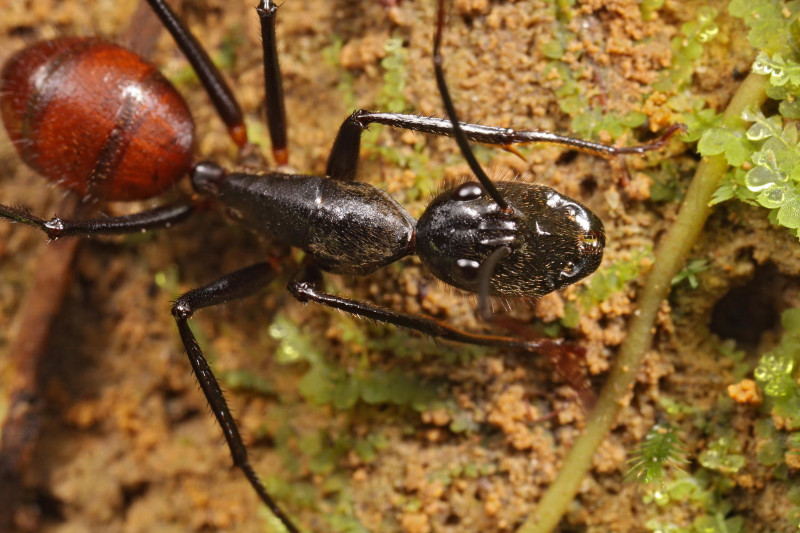
CCL: https://bit.ly/3sip5ce
Giant Forest Ant Facts
- This impressive and distinctive creation of Nature and evolution, quite understandably, most frequently goes by the common name of the Giant Forest Ant. Unlike many species found around the world, for the moment the insect has no other broadly accepted common name.
- Professional researchers, meanwhile, generally refer to the remarkable creature by another term. That’s because those professionals usually apply its formal scientific name when speaking of it. That, however, is the less than easily pronounced term of Dinomyrmex gigas.
- The invertebrate received that official name at the hands of the renowned French zoologist, Pierre Andre Latreille. This respected researche made the first recorded acknowledgement of it as a separate and distinct species. That scientifically noteworthy action occurred in 1802.
- Regardless of which term one chooses to employ when referrring to it, though, it stands out from the majority of its many kindred. It also represents the only known member of its genus, further distinguishing it. At least one known subspecies does appear to exist, however.
- The Giant Forest Ant appears to be maintaining a population base that’s both stable and sizeable. That condition further seems to hold true throughout the entirety of its native range. The IUCN, therefore, currently has no listing for it on its Red List of Threatened Species.
- This majestic Arthropod nevertheless must be considered to be facing at least some potential threats, like most species. These naturally include the potential danger of habitat loss. Its greatest threat, however, most likely consists of the ongoing peril of climate change.
Related Articles
Giant Forest Ant Physical Description
The amazing Giant Forest Ant impresses those people fortunate enough to encounter it for a variety of reasons, of course. Likely its most impressive feature, however, remains its sheer size. That’s due to the fact that this particular variety of ant ranks as one of the largest in the entire world.
The marvel of evolution further qualifies as the largest of all known ants in its entire region of the world. Sizes vary between individuals, of course, due to the very nature of ants. That’s because members of different castes have different attributes. That statistic extends to sheer size as well.
Normal workers within each colony attain an average overall length measuring a relatively impressive 0.82 in (20.9 mm). The significantly larger soldiers of each colony, however, reach even greater mean lengths. Members of that caste display an average length of roughly 1.11 in (28.1 mm).
The queens of this amazing species, meanwhile, grow to even greater sizes, as holds true for most known ants. Each queen of this remarkable invertebrate grows to approximately 1.22 in (31 mm) in overall length. These measurements truly drive home the incredible size of these invertebrates!
The general physical appearance of the Giant Forest Ant, apart from its uncommon size, strongly parallels that of other ants. It does manifest bright yellow fur on its legs, unlike others, though. The main body shows a dark brown shade, yet the posterior displays a much lighter, reddish-brown hue.
- Kingdom: Animalia
- Phylum: Arthropoda
- Class: Insecta
- Order: Hymenoptera
- Family: Formicidae
- Genus: Dinomyrmex
- Species: D. gigas
Giant Forest Ant Distribution, Habitat, and Ecology
The marvelous Giant Forest Ant appears to inhabit a moderately large swathe of the surface of the globe. More specifically, the Arthropod inhabits much of the southeastern portions of the continent of Asia. It still remains somewhat unclear, however, if the arthropod ever possessed a greater range.
The northern-most region of its known range includes both the countries of Thailand and the Philippines, though separated by a large expanse of ocean. From there, though, the intrepid insect extends its range through parts of Malaysia and Borneo, and into much of the country of Indonesia.
In all the numerous regions that it inhabits, however, the invertebrate displays very strong preferences in its choice of ecosystems to dwell in. Primarily, the insect makes its home, as the name implies, in the relatively dense regions of rainforest found throughout this region of the world.
Yet this intriguing product of millions of years of evolution also appears, though, in notably smaller concentrations, in a few other types of habitat. These varying ecosystems might surprise many, as they include such highly diverse areas as regions of mangrove forest, and peat swamps.
The extraordinary creature also chooses to llive at a surprisingly wide range of altitudes, unlike some related species. In point of fact, it makes appearances from near sea level up to about (1,500 m) above sea level. There, the animal sometimes makes its home in regions of montane forest.
The undeniably impressive Giant Forest Ant also differs from many of its relatives on earth today in its behavioral patterns. Most ants forage primarily by day, but not this one. These productive ants conduct the great majority of the their many activities at night, including, of course, foraging.
The vast majority of the diet of this distinctive ant, an impressive 90 percent, consists of honeydew. The remainder includes small insects, such as winged termites. The animal also consumes smaller quantities of other food options, such as nectar, sap, and even quantities of bird droppings.
Species Sharing Its Range
Check out our other articles on 3 Fabulous North American Felines, Guinan cock-of-the-rock, Ball’s Pyramid, Alaskan Timber Wolf, Kauai hau kuahiwi, Saltwater Crocodile, Purple Frog
